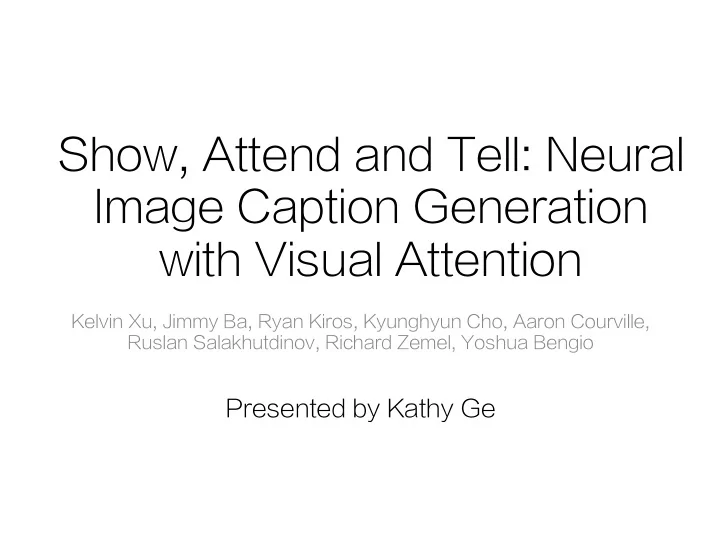

Show, Attend and Tell: Neural Image Caption Generation with Visual Attention Kelvin Xu, Jimmy Ba, Ryan Kiros, Kyunghyun Cho, Aaron Courville, Ruslan Salakhutdinov, Richard Zemel, Yoshua Bengio ¡ Presented by Kathy Ge
Motivation: Attention “attention allows for salient features to dynamically come to • the forefront as needed”
Image Caption Generation with Attention Mechanism Encoder: lower convolutional layer of a CNN • Decoder: LSTM which generates a caption one word at a time • Attention mechanism • Deterministic “soft” mechanism – Stochastic “hard” mechanism – Output: •
Encoder: CNN Lower convolutional layer of a CNN is used, to capture spatial information • encoded in images annotation vector •
Decoder: LSTM where i t , f t , c t , o t , h t are the input, forget, memory, output, and hidden state of • the LSTM at time t is the context vector which captures the visual information associated • with a particular input location is the embedding matrix •
Learning Stochastic “Hard” vs Deterministic “Soft”Attention Given an annotation vector a i , i = 1, …, L for each location i, an attention • mechanism generates a positive weight Weight of each annotation vector is computed by an attention model f att using a • multi-layer perceptron conditioned on previous hidden states h t-1 Define a function which computes the context vector z t given the annotation • vectors and corresponding weights Given the previous word, previous hidden state and context vector, compute • output word probability
Deterministic“Soft” Attention Compute expectation of context vector directly • Then can compute a soft attention weighted annotation vector • This model is smooth and differentiable, can be computed using standard • backpropagation
Doubly Stochastic Attention When training the deterministic version of the model, can introduce a doubly • stochastic regularization, where This encourages model to pay equal attention to every part of the image • throughout the caption generation In experiments, improved overall BLEU score, and lead to more rich and • descriptive captions The model is trained by minimizing the negative log likelihood with penalty •
Stochastic “Hard” Attention Let s t represent the random variable corresponding to the location where the • model decides to focus attention at the t th word where z t is a random variable, and s t are intermediate latent variables •
Stochastic “Hard” Attention Define objection function, L S , the variational lower bound • Gradient w.r.t. parameters of model, W • where
Stochastic “Hard” Attention Reduce estimator variance by using a moving average baseline and • introducing entropy term H[s] Final learning rule: gradient w.r.t. parameters of model, W • where λ r, λ e are hyperparameters, and b is exponential decay used in calculating moving average baseline At each point, returns a sampled a i at every point in time • based on a multinomial distribution parametrized by Similar to REINFORCE rule •
Experiments Evaluated performance on Flickr8K, Flickr30K, and MS COCO • Optimized using RMSProp for Flickr8K and Adam for Flickr30K/MS COCO • Used Oxford VGGnet pretrained on ImageNet • Quantitative results measured using BLEU and METEOR metrics •
Qualitative Results
Mistakes
“Soft” attention model A woman is throwing a frisbee in a park.
“Hard” attention model A man and a woman playing frisbee in a field.
“Soft” attention model A woman holding a clock in her hand.
“Hard” attention model A woman is holding a donut in his hand.
Conclusion Xu et al. introduce an attention based model that is able describe the contents of • an image The model is able to fix its gaze on salient objects while generating words in the • caption sequence They compare the use of a stochastic“hard” attention mechanism by • maximizing a variational lower bound and a deterministic“soft” attention mechanism using standard backpropagation Learned attention model can give interpretability to model generation process, • and through qualitative analysis can show that alignments of words to locations in an image correspond well to human intuition
Thanks! Any questions?
Recommend
More recommend